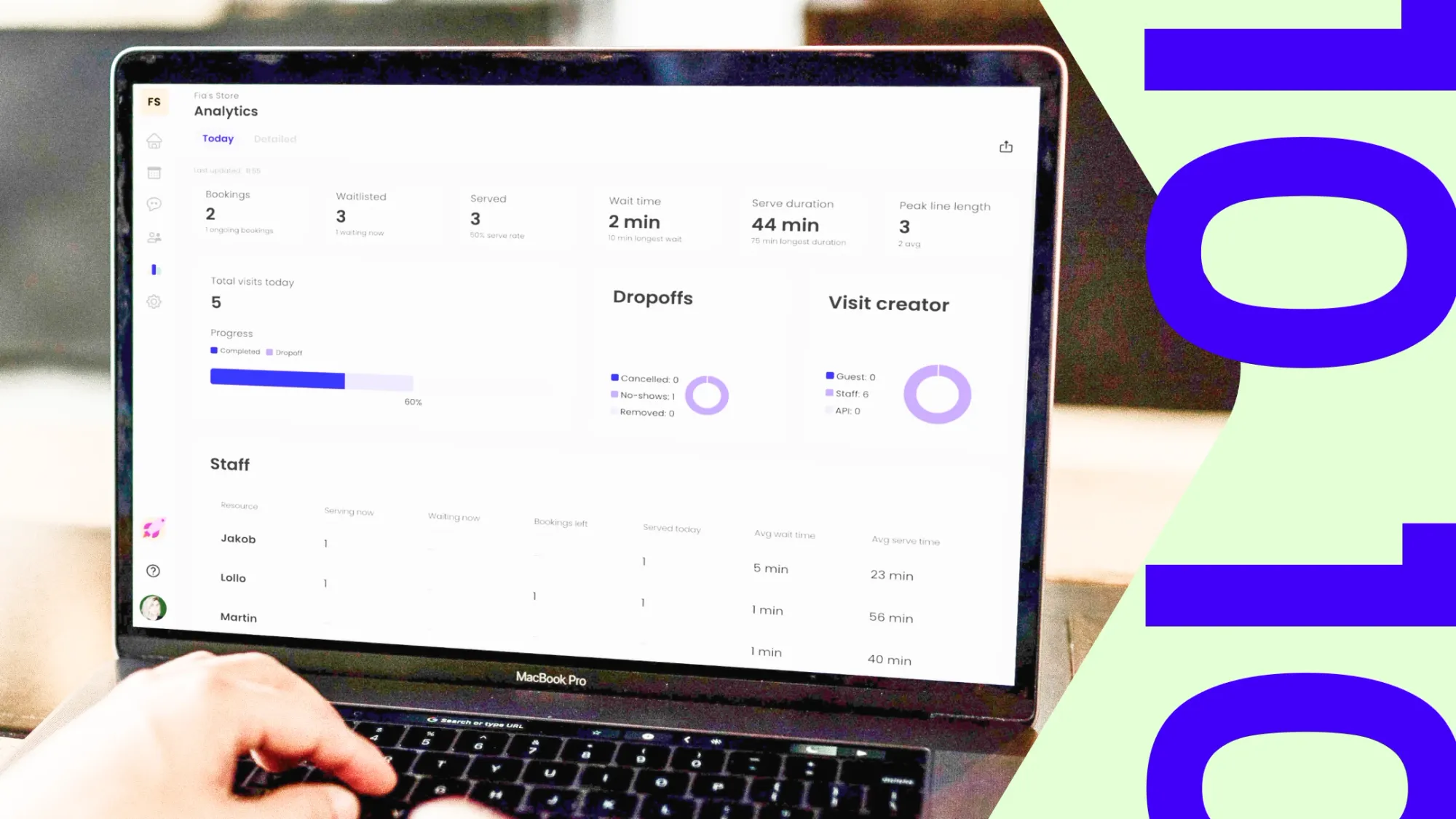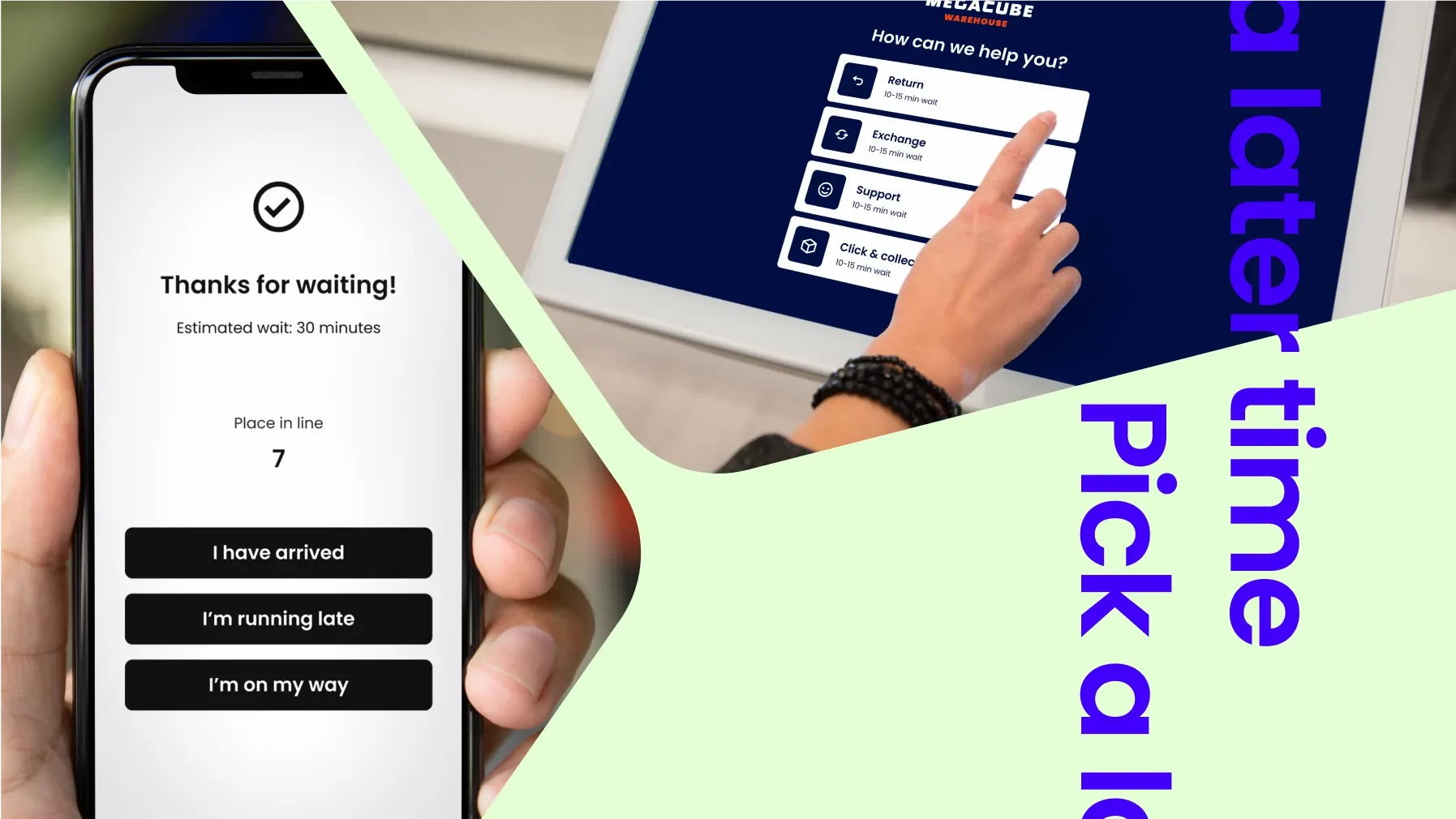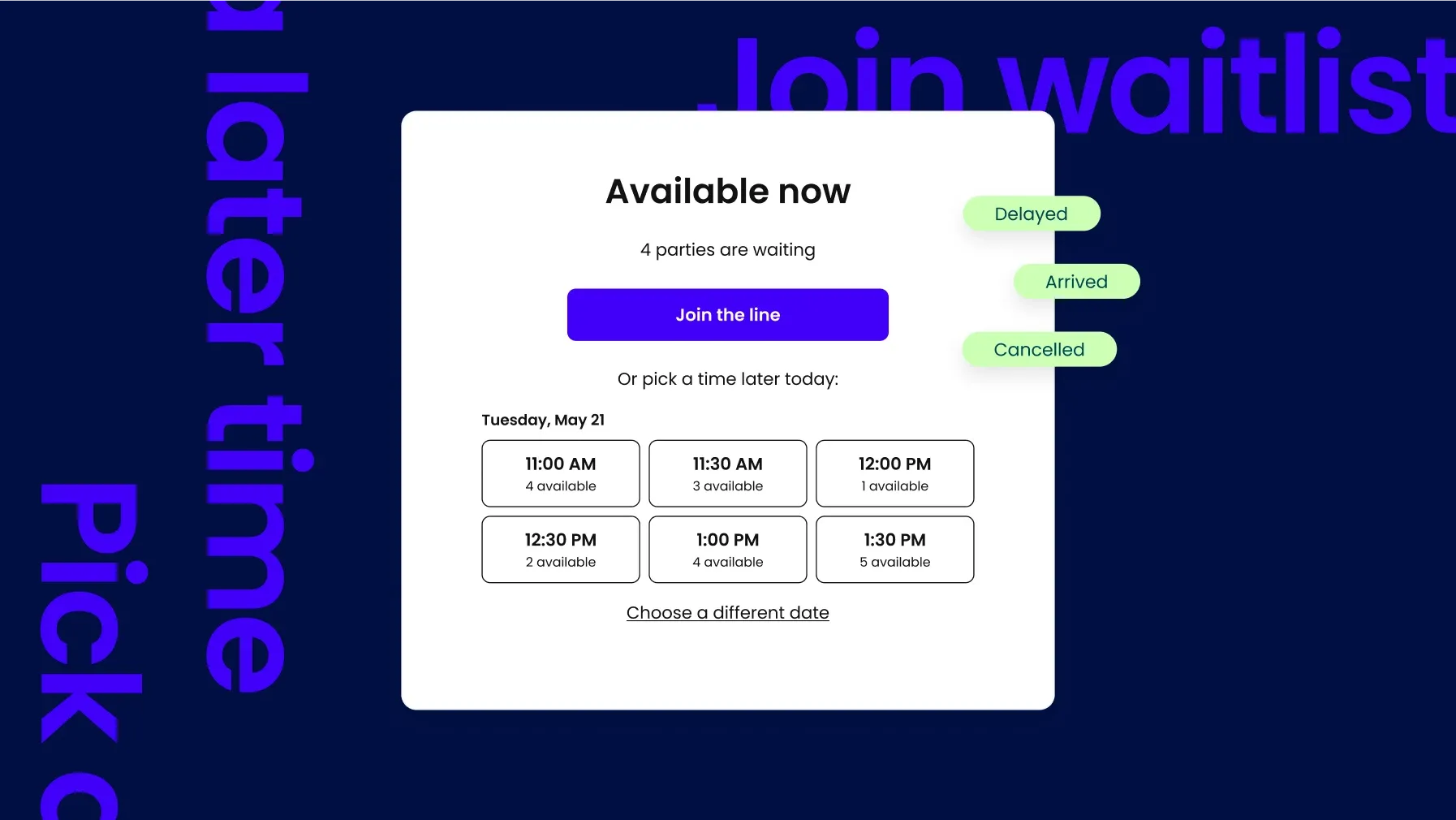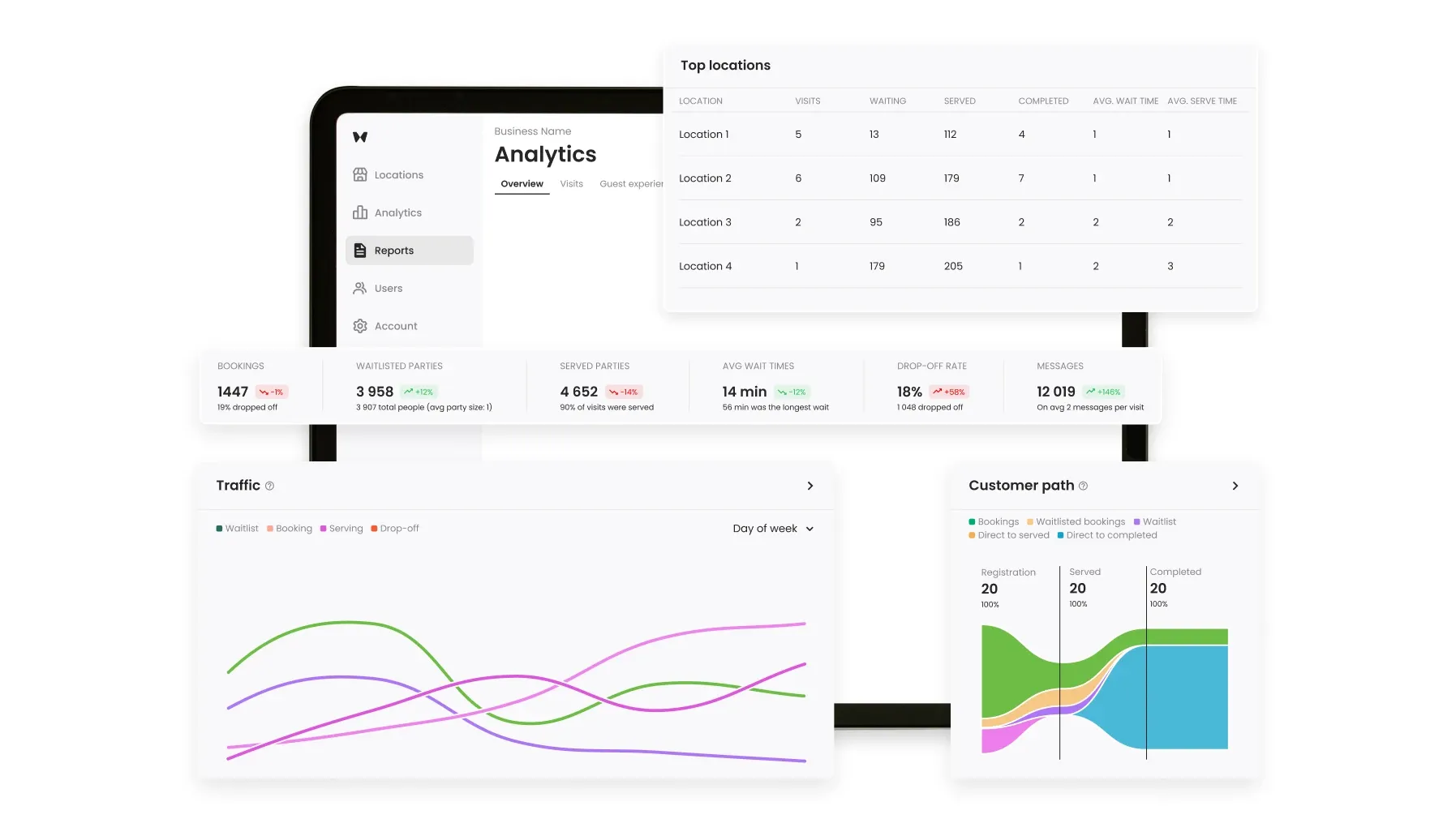10 benefits of a queue management system
If your business has a problem with long lines or wait times, a queue management system is the perfect solution. Here are the top benefits of virtual queues.

Long lines and wait times are a persistent problem across virtually every industry. In the U.S. alone, Americans spend roughly 37 hours each year waiting in line.
And studies show that people really don’t like waiting in line. Waitwhile consumer research has shown for two years in a row that waiting in line is associated with negative emotions. 67% of consumers report feeling impatient, bored, annoyed, frustrated, or disrespected when they have to wait.
This can have serious impacts on your business. The same survey revealed that 44% of consumers are less satisfied with businesses that have lines and 82% of consumers actively avoid going to a business because there’s a visible line or because they think there will be a line.
In today’s digital-first world, consumers have high expectations. We’ve been trained by technology to get what we want quickly. As a result, people have less patience and the expectation for speedy service is climbing consistently.
So, businesses that regularly have lines and waits need to find a solution quickly – or they risk falling out of favor with today’s convenience-driven consumer. By implementing a queue management system, you can modernize how visitors wait at your business and make both employees and customers happier with virtual queues.
Here are the 10 benefits of using a queue management system.
1. Shorter wait times
A core feature of queue management systems is that they produce shorter wait times. This happens in two different ways.
First, virtual queues allow your visitors to wait from anywhere. They can see an accurate wait time – with Waitwhile, intelligent wait times are delivered with AI – and then join your virtual queue from any device. During the wait period, guests receive consistent updates on their status and are able to do anything they’d like. This increased agency turns unproductive time (standing in a physical line) into occupied time, making the wait feel significantly shorter – or even eliminating the feeling of having to wait altogether.
Queue management systems also bring increased productivity and efficiency to your business – which we’ll discuss throughout this article. This speeds up service processes and subsequently reduces wait times across the board.
2. Happier customers
As we mentioned earlier, lines and wait times are correlated with poor customer satisfaction. Not only is waiting in line associated with negative emotions for the vast majority of consumers, but a recent Waitwhile survey found that 57% of consumers feel like they are wasting time when they have to wait in a physical queue.
When asked about whether they’d like to wait in a physical line or a virtual line, over 68% of consumers said they prefer virtual queues.
Given this strong response, a queue management system is a no-brainer when it comes to improving customer satisfaction at your business.
3. More options for visitors

The best queue management systems provide businesses with flexibility to structure operations in the most optimal way. This includes giving customers the option to join a virtual queue in a number of different ways:
- At home, so they can show up right when it’s their turn
- Within a certain geographical radius of your business (geofencing)
- By texting your business’ phone number
- Online via your website
- Directly in your Google Maps listing
- Using a QR code at your business
Queue management systems like Waitwhile allow you to offer any or all of these options based on whether they make sense for how your business runs. Consumers appreciate the flexibility of multiple options.
Platforms like Waitwhile also seamlessly integrate appointment scheduling features. A recent Waitwhile survey found that almost 70% of consumers would rather make an appointment than wait in a line.
If it makes sense for your business, you can offer customers the option to either book an appointment in advance or to join a virtual queue in real time. With Waitwhile’s Line Sync, appointments and virtual queues are automatically integrated into one line while making the wait fair for everyone.
4. Enhanced employee productivity
A core benefit of virtual queues is that so many aspects of queue management are automated. Physical queue management is tedious and manual: employees have to estimate waits, manage lines or crowds, find customers whose turn is coming up, etc.
With a queue management system, all of this is handled by tech. Accurate wait times are delivered to visitors right from the start so they know what to expect. All communication is handled through automated notifications or texts, so visitors are kept in the loop. When their turn is coming up, customers receive a ping. If they need more time or are running late, they can simply respond and the queue management system will automatically rearrange the queue accordingly – keeping service flowing smoothly.
This automation frees up staff time. Businesses no longer need employees to manually manage physical queues or crowds. Instead, staff get more meaningful face-to-face time with customers and can focus on what matters most: delivering standout customer service.
5. Improved staff morale
Because waiting in line is so closely associated with negative emotions for consumers, this has an impact on staff morale. Customers who are frustrated because they have to wait in line are more likely to not only take longer once it’s their turn, but are also likely to take out their frustration on frontline staff. This has serious implications for employee satisfaction.
A March 2023 Waitwhile survey of frontline retail workers found that 68.5% regularly have to deal with frustrated or angry customers. When asked about the main cause of customer frustration, long wait times was the #1 response.
With consumer impatience on the rise, frontline workers are bearing the brunt of the burden. According to The Conversation, “decreased patience and increased emotionality are real problems for service-based organizations and employees, along with the quiet quitting, ‘great resignation’ and ensuing shortage of talent they fuel.” Customer-facing employees are leaving their jobs at alarming rates due to consumer incivility, creating worker shortages in key industries like retail, food service, and hospitality.
Queue management systems mitigate this risk by reducing rates of consumer frustration. Research has shown that consumers far prefer virtual queues to physical lines. Because a queue management system will make customers happier, frontline staff are less likely to feel anxious or stressed at work, improving employee morale and retention.
6. Better 2-way communication

One of the core advantages of a queue management system is that it creates a clear line of communication between you and your customers. Platforms like Waitwhile have 2-way communication via text message or email after customers join a virtual queue.
We’ve already talked about the automated notifications that you can send customers to update them on their wait status. In addition to these pre-programmed messages, you can also chat directly with visitors, answering questions they might have or sending one-off reminders. Additionally, you can ask customers to do things while they wait, like filling out forms or specifying service requests.
Because important forms are filled out and questions are answered ahead of time, customers will require less time once it’s their turn. This adds key efficiencies to your operations. With a shorter service time, you can increase your service capacity without needing to hire additional staff.
7. First-party customer data and insights
Another core benefit of a queue management system is that you get to generate a repository of customer data and insights. Platforms like Waitwhile allow you to customize the information you collect from your visitors. You get to decide what fields (e.g., name, phone number, party size, language, etc.) are required when guests join your virtual queue, so that you can slice your data to see cohort-specific metrics.
With this capability, you can spot important trends in customer traffic and adjust your operations accordingly. For example, you may notice an increase in Spanish-speaking customers on certain days of the week. To better serve your clientele, you may make the decision to increase your Spanish-speaking staff on these days.
Queue management systems also have core note-taking capabilities that allow you to build relationships with customers. Your staff can take notes on each customer interaction, detailing things like preferences or notable identifiers. That way, every time a customer returns to your business, you can deliver a personalized experience regardless of whether or not they’re being served by the same staff member.
8. Real-time monitoring and reporting

In addition to the customer data you’re able to collect, queue management systems like Waitwhile can also serve as your operational command center. That’s because a queue management system automatically collects operational analytics so you can monitor your location traffic and queues in real time.
Whether you operate 1 or 1000 locations, you can see how many guests are waiting, current wait times, upcoming appointments, and other metrics that will help empower your team. If there’s an issue, you’ll be able to spot it quickly and get to the bottom of it before it spins out of control.
Additionally, you’ll be able to track historical trends to glean insights from your data. See business trends sorted by location, time period, employee, or service – whatever helps you take your business to the next level.
9. Higher sales
Virtual queues are tied to higher sales. A recent Waitwhile consumer survey found that nearly 40% of consumers said they would continue shopping at a business while queuing virtually.
This takes the concept of impulse goods – products often found in checkout lines that people buy without planning to do so – and expands it to your entire store. Because customers don’t have to wait in line, they can instead spend that newly free time browsing your entire store, discovering items they may not have initially planned on buying.
Also, don’t forget that virtual queues speed up the service process. With a faster serve time, you’ll be able to serve more customers per day, driving overall sales.
10. Lower operating costs
The efficiencies that queue management systems bring to your business translate into real cost-savings when it comes to your operations. With all aspects of queue management automated and key service steps handled ahead of time, you can reduce overall workforce costs.
The operational data you get from a queue management system can also inform your staffing. You’ll be able to see key traffic trends so that you can staff appropriately, reducing the number of employees during slower times of day or days of the week.
Queue management system benefits: The takeaway
The benefits of a queue management system are indisputable: providing alternatives to long lines and wait times will have positive impacts across the board. Customers that can wait in a virtual queue will be happier overall, leading to higher employee satisfaction. Plus, queue management systems bring core efficiencies to operations and provide you with valuable data that you can use to further improve how your business runs.
The best part of a queue management system is how affordable it can be. Solutions like Waitwhile offer flexible pricing so you can build the plan that works for you.
With consumer expectations for personalization and convenience climbing, businesses must work quickly to improve their customer experience. A queue management system will eliminate the “timeless torture” of waiting in line and give your business a key competitive edge.
